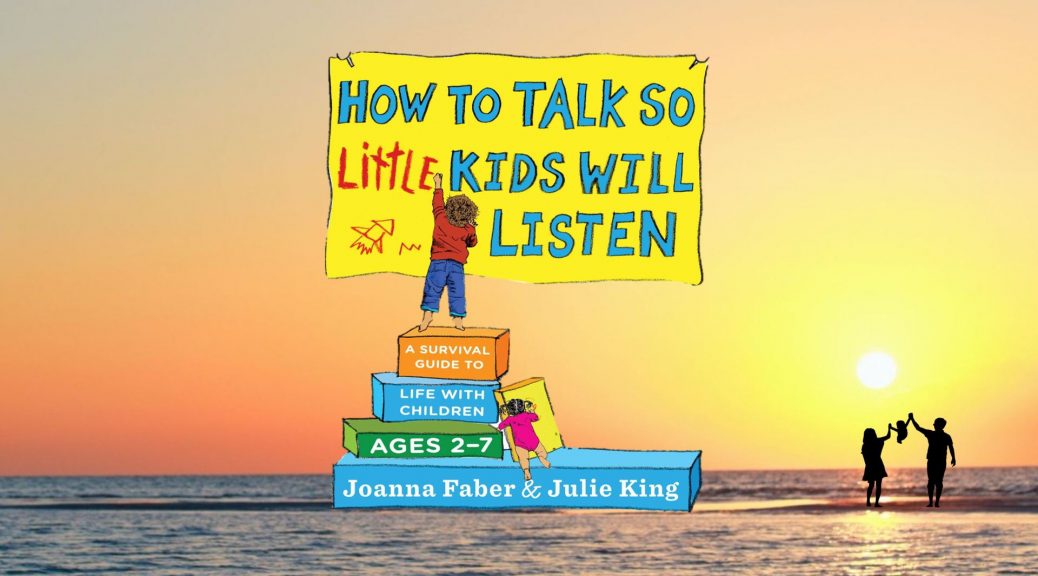how to talk so little kids will listen | summary
All Rights are held by Faber and King, post is for educational purposes.
The following are notes on how to parent effectively for toddlers by Joanna Faber and Julie King, who just so happen to be the children of Adele Faber and Elaine Mazlish the authors of “How To Talk So Kids Will Listen & Listen So Kids Will Talk” fame. I have found these technique very useful, not just with kids but my spouse and colleagues! Strange but true.
Part 1: Chapter 1
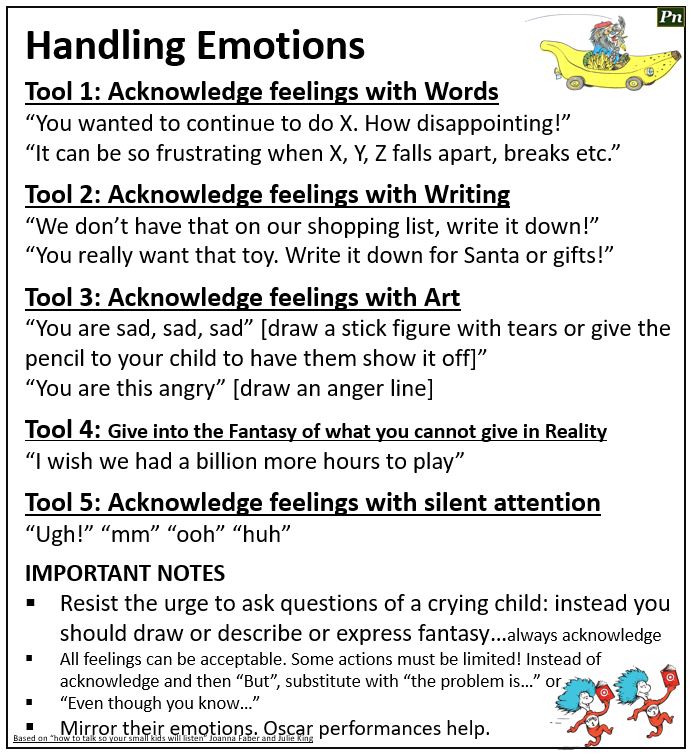
Handling Emotions
Tool 1: Acknowledge feelings with Words
- “You wanted to continue to do X. How disappointing!”
- “It can be so frustrating when X, Y, Z falls apart, breaks etc.”
- Acknowledging feelings is critical. Imagine telling an adult that their desire to sleep in on Monday “would get up fired, fool!” or that “you’re not really tired!” We as adults often just want to be heard, we don’t actually want to solve our problem we want to express our emotions and get sympathy not solutions. Whether you’re a co-worker, adult friend or child, the best way to get on someone’s side is to empathize with them.
Tool 2: Acknowledge feelings with Writing
- “We don’t have that on our shopping list, write it down!”
- “You really want that toy. Write it down for Santa or gifts!”
- Documenting considerations, writing things down is sometimes viewed as a liability. In reality, writing things down will help shift your mind off of the consideration and make space for other matters. In negotiations, repeating what your counterparty has just said is a powerful mirroring technique. With a child, writing considerations down = problem solving and it works to calm them.
Tool 3: Acknowledge feelings with Art
- “You are sad, sad, sad” [draw a stick figure with tears or give the child the pencil to your child to have them show it off]”
- “You are this angry” [draw an anger line]
- Pencil out exactly how your child feels, this will help them to calm down, stop screaming and crying will lead to maturity. This same logic is precisely why powerpoint presentations have such a dopamine effect, a good powerpoint provides the illusion of completeness, clear, compelling and memorable. At a minimum, you will feel better after having a visual medium represent your concerns. Same applies to your child.
Tool 4: Give in Fantasy what you cannot give in Reality
- “I wish we had a billion more hours to play”
- When you wish upon a star….our aspirations are very different for our reality. It is cathartic to express those aspirations. As long as those aspirations aren’t too crazy. A lack of imagination is a scary thing, be mindful of people who are insecure about their own lack of imagination. Kids though, they are unencumbered by a world view….let dreams relax them.
Tool 5: Acknowledge feelings with silent attention
- “Ugh!” “mm” “ooh” “huh”
- In a negotiation, a long pause is sometimes the most effective tactic to come to an agreement. With kids, the same is true. Let your child know that you aren’t trying to monopolize their mind. Stop talking so much. Be comfortable with silence. You will be happier at work, with your spouse and your kids.
IMPORTANT NOTES
- All feelings can be acceptable. Some actions must be limited! Instead of acknowledge and then “But”, substitute with “the problem is…” or “Even though you know…”
- Letting a child get to the acceptance stage and then smacking them back down with a “but….” is the worst. Don’t go into the solution phase too quickly.
- Resist the urge to ask questions of s crying kid
- Mirror their emotions. Oscar performances help.
Part 1: Chapter 2
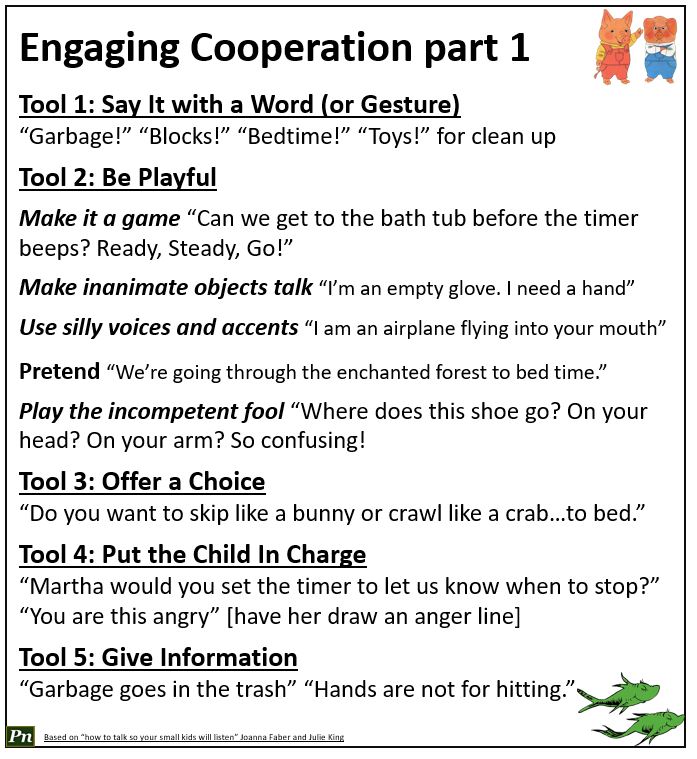
Engaging Cooperation
Tool 1: Say It with a Word (or Gesture)
- “Garbage!” “Blocks!” “Toys!” to indicate clean up.
- Instead of stating three or four words, just say one word for example, instead of “don’t forget to put your chairs back” just say “chairs.” Rather than overtly tell an adult the exact thing you want them to do, give them more flexibility to internalize the problem and then correct it themselves. People want to be empowered. By enabling the receiver, of a single word command, the chance to digest the problem and then interpret the likely solution, you are going to get a higher rate of compliance. Works with kids, by the way.
Tool 2: Be Playful
- Make it a game “Can we get to the bath tub before the timer beeps? Ready, Steady, Go!”
- Setting a unique goal will help motivate. For example, calorie counting using Weight Watchers, helps moderate consumption. Gamification is not just a fad from the 2010s, we are wired to play and compete. Talk like a duck, avoid lava, or take a fake energy pill, these are games to get your child onside. However, if you do the opposite you will be in trouble: “If you throw sand one more time…” Throwing sand one more time is a challenge. Setting a red line in the sand will dare your opponent to cross that red line. Therefore do not say that phrase.
- Getting a child to wear a winter coat can be difficult. You could create a temperature measurement graph and then indicate the current days temperature and then suggest that this was the temperature for wearing a coat. This way, instead of telling your child what to wear you can check the thermometer, have him or her check the thermometer and tell you what they need to wear. This exact same model is used in the financial sector through the policy rate of any country’s central bank. Macro-economic forecasting realize on generalizable indicators such as the employment numbers.
- Make inanimate objects talk “I’m an empty glove. I need a hand”
- Try the very hungry nail cutter nail clippers that talk to your child….
- Use silly voices and accents “I am an airplane flying into your mouth”
- Humour is one of the best antidotes to master/slave relationships at work or at home. If you can make your counterparty smile or laugh then you are in a strong position to influence and effect positive change.
- Pretend “We’re going through the enchanted forest to bed time.”
- Painting visual pictures in the minds of your audience will get them far more into your mindset and ideas then otherwise. Visual hooks are a powerful persuasion technique. Pretending to fly in public might be embarrassing but it beats yelling at your kid!
- Play the incompetent fool “Where does this shoe go? On your head? On your arm? So confusing!
- Making minor mistakes drives perfectionists mad. But perfectionists are rarely the most effective co-workers. As with your kids, little mistakes done playfully can unwire a bias toward ideological thinking and can unleash creativity in others.
Tool 3: Offer a Choice
- “Do you want to skip to the X like a bunny or crawl like a crab”
- Probably the most widely used parenting technique. At work, if you give the colleague the power to choose a path for themselves they will be more likely to follow you. Avoid false choices like “I can spank you with my rights hand or my left hand.”
- Picky eaters for example: having a meal plan where the child can checkmark which option they would like to eat is an example of empowering your child.
- If a colleague isn’t feeling a meeting, then you should consider closing up early. Do not feel obligated to take the full hour because you booked an hour.
Tool 4: Put the Child In Charge
- “Martha would you set the timer to let us know when to stop?”
- “You are this angry” [have her draw an anger line]
- Giving your co-worker the chance to present their views uninterrupted is important. Let them field their ideas in public or in private conversations. That will give rise to more cooperation. Same deal with kids.
Tool 5: Give Information
- “Garbage goes in the trash” “Hands are not for hitting.”
- Stating the rules, re-enforces their usage.
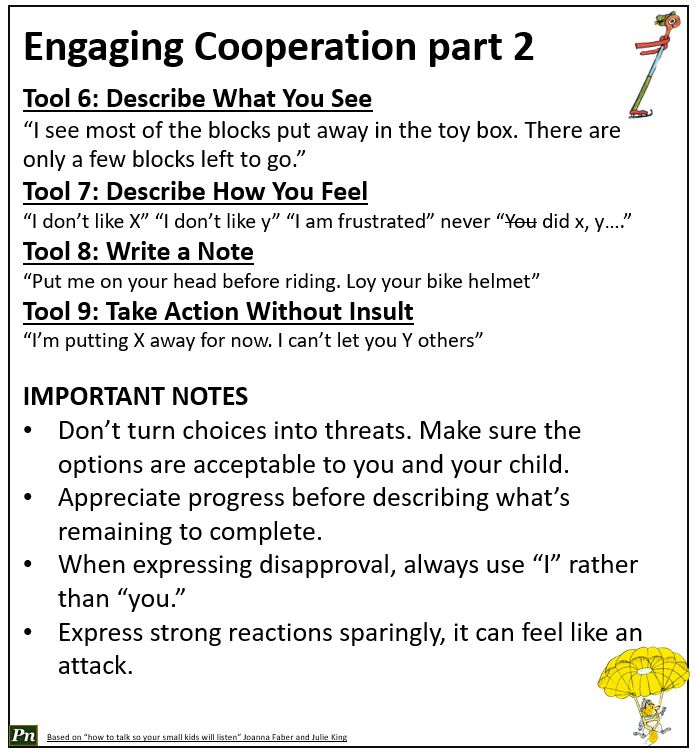
Tool 6: Describe What You See
- “I see most of the blocks put away in the toy box. There are only a few blocks left to go.”
Tool 7: Describe How You Feel
- “I don’t like X” “I don’t like y” “I am frustrated” never “
Youdid x, y….” - Instead of saying, “you spilled the milk” you can say “I really don’t like it when milk is spelt”. Instead of being accusatory towards the other person with “You”, you’re saying “I” have a problem with that this technique. This technique is universally effective wherever people are involved. Try it with your kids.
Tool 8: Write a Note in the Voice of Objects or Requirements
- “Put me on your head before riding. Love, your bike helmet”
- Make a sign that says kitchen open at 7AM so that your child knows not to come into the kitchen until 7AM.
Tool 9: Take Action Without Insult
- “I’m putting X away for now. I can’t let you Y others”
IMPORTANT NOTES
- Don’t turn choices into threats. Make sure the options are acceptable to you and your child.
- Appreciate progress before describing what’s remaining to complete.
- When expressing disapproval, always use “I” rather than “you.”
- Express strong reactions sparingly, it can feel like an attack.
Part 1: Chapter 3
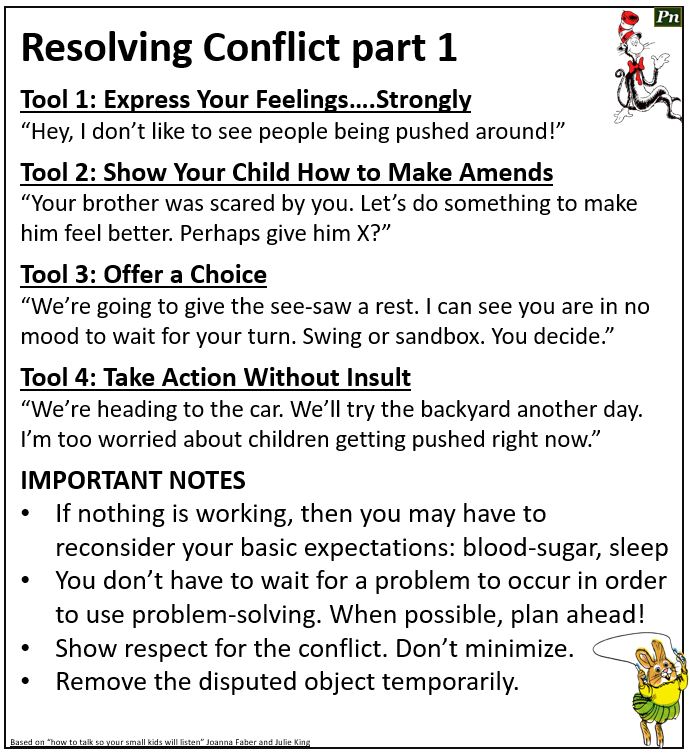
Resolving Conflict
On Rewards and Punishments:
- If you do this then I give you that doesn’t work. Rewards don’t work because they are subject to inflation overtime and eventually he or she will wants a new house for getting dinner done for 6pm 5 days in a row. Reward to help with mechanical and simpleton tasks but as soon as it involves creativity rewards backfire.
- There are three drivers for children:
- Autonomy: the ability to be self-directed;
- Mastery: to master a subject or problem;
- Purpose: the sense that the work has purpose or value.
- Replace punishment with more peaceful solutions. The only consequences that you can really manage are logical ones which are subjective. Logic, math are human constructs. Punitive consequences aren’t viable in the working world because employees have choice.
- Timeouts do not work because it does not address the problem. Turns out that it doesn’t lead the child to think “Geez, I should respect my sister and brother, as a result of my actions, I am in a time out.” In reality, the child is more likely to think “it’s not fair and I hate my sister for forcing me to be in the time out. She pushed me first!” Or even worse, “I’m mean to my sister, I am a bad person! Unforgivable!”
- Natural consequences like gravity pulling you down causing your child to hit the ground are the best teacher because the child is 100% owning the decision, action and the consequences but when you’re intervening, you are applying a logic to the situation.
- For example, if you come to my class late “the door will be locked” or “you’ll have to stay after the class”…These aren’t really true exercises in logic. More of a free association to make the offender suffer. These approaches you between yourself and your child.
- Getting a consequence and a punishment….the child is still getting pain in the hope of changing their behaviour.
- But why do we punish? Physical abuse doesn’t really work. Punishment works for some kids, I was a miserable kid in the short-term. It produces quick results…
- You might have to use the harsher punishment. But it doesn’t help in the long run.
- Kids who are punished through corporal punishment are more likely to misbehave in the future, according to some studies. Of course, in longitudinal studies of those children, it’s hard to know how much personality/self discipline play into these decisions.
- Kids who are punished hardly can develop fear and aggression towards other children!
Tool 1: Express Your Feelings….Strongly
- “Hey, I don’t like to see people being pushed around!”
- Alternative to punishment: give the child the opportunity to learn from their mistake.
Tool 2: Show Your Child How to Make Amends
- “Your boy was scared by you. Let’s do something to make him feel better. Perhaps give him X?”
- If a colleague has made a grievous error, then give them a chance to be the hero. This is the same for children. Show your child how to make amends. The best chance to get a child to do something better is to give them a chance to redo what they just did. Give them a re-write. This way he or she can see there’s a potential actual to do good.
- So first you comfort your daughter and express your disappointment with your son. You can come up with some ideas like he can play with the blocks in his room or he can play with the blocks when his sister is not around. Maybe he needs a special word for you to come in to intervene and prevent his sister from attacking his town. Get your son to think about how to make his sister happy so that she does not attack his blocks….
Tool 3: Offer a Choice
- “We’re going to give the see-saw a rest. I can see you are in no mood to wait for a turn. Swing or sandbox. You decide.”
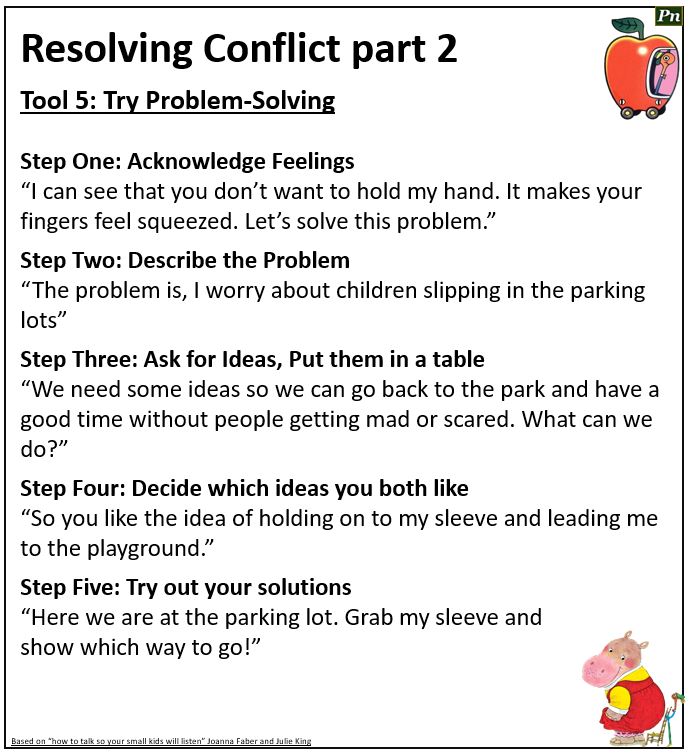
Tool 4: Take Action Without Insult
- “We’re heading to the car. We’ll try the backyard another day. I’m too worried about children are getting pushed right now.”
- I take action to protect the child from harm, this is not about providing consequences or punishment for those consequence. I’m putting the blocks away for now, I’m too worried. I don’t want to see broken heads or bones.
- “We’re leaving the library, I can’t afford to have books thrown on the floor.” What could be more valuable than punishment as the average parent? Freaking artificial punishment for actions don’t work either.
Tool 5: Try Problem-Solving
Step One: Acknowledge feelings
- “I can see that you don’t want to hold my hand. It makes your fingers feel squeezed. Let’s solve this problem…”
- Get the child on the same team. First, except the emotional joy of riding a tricycle in the living room. Second, can you define what the problem is which is that your little sister could get her fingers caught in the wheels. Thirdly, we need an idea to solve for the problem.
- Acknowledge their feelings then get them involved in the problem-solving. Don’t develop solutions in a vacuum.
- Have your kids come up with a way to solve problems. Don’t try to solve the problem for the child.
- If there is a dispute over who should have control over the remote, for example, don’t make the dispute something you can belittle because it’s important to the child.
Step Two: Describe the ProblemJoanna Faber and Julie King
- “The problem is, I worry about children slipping in the parking lots”
- Make sure you have a short explanation of what the problem is. The problem statement has to be short and touch on how that problem affects you as the parent. Simplicity is key at this stage. The classic business statement is: “I’m not sure we’re asking the right questions, solving the right problem.”
Step Three: Ask for Ideas, Put Them in a table
- “We need some ideas so we can go back to the park and have a good time without people getting mad or scared. What can we do?”
- Giving your colleagues the chance to test out their ideas in the wild is critical to helping resolve deadlock. You need to ask to document out all the truly preposterous ideas from your child and put them down into this discussion. Build your list with your child’s and your ideas, find ideas that you both like. If the child has come up with a solution, then they will want to test it out if they never get a chance to test out the solution then they will not want to play.
Step Four: Decide which ideas you both like
- “So you like the idea of holding on to my sleeve and leading me to the playground.”
Step Five: Try out your solutions
- “Here we are at the parking lot. Gram by sleeve and show which way to go!”
- So you have an example of a kid who doesn’t want to take a shower because he doesn’t want to wash his hair and get water in his eyes. So you sit him down with a ledger but the kid wants to put down some strange ideas. That’s ok. He comes up with some creative solutions. Parent asks: “what animals do you like shower with?” Child says “A fish!” Parent replies: “Ok which animals don’t like showers and water?” Child answers “Cats!” Parent asks “what about at the swimming pool? How can wash your hair without getting water in your eye?” Child says “I wear goggles at the swimming pool…” Parent answers, “OK then next time you should wear goggles in the bath tub and I can wash your hair!”
- The week before an airplane flight you can come up with a game with a list of things you can do while being stuck in the seat. Each kid might wanna pack colouring books instructions on how to build an airplane 20 questions game.
IMPORTANT NOTES
- If nothing is working, you may have to reconsider your basic expectations: blood-sugar, sleep etc.
- You don’t have to wait for a problem to occur in order to use problem-solving. When possible, plan ahead!
- Show respect for the conflict. Don’t minimize.
- Remove the disputed object temporarily.
Part 1: Chapter 4
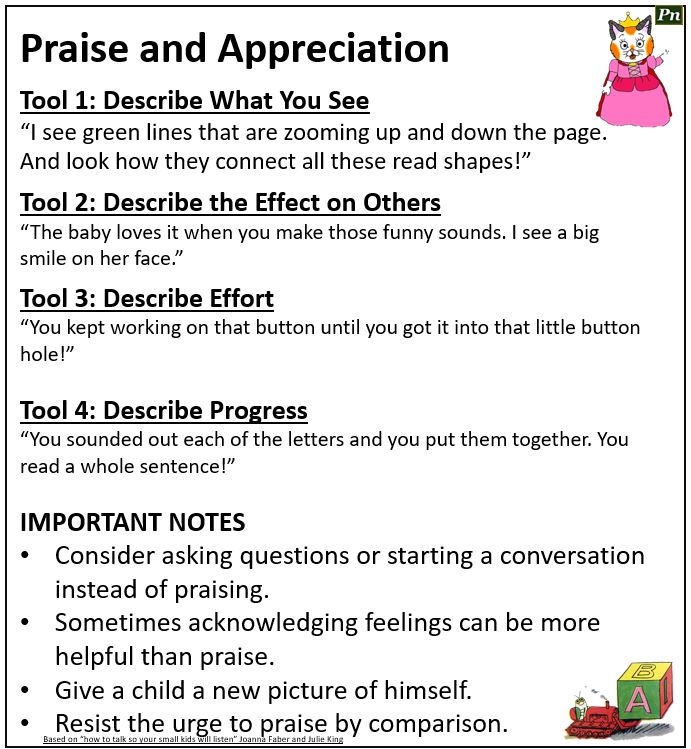
Praise and Appreciation
The Dangers of Praise
- Praise can often backfire! For example it might make your child feel threatened. At work, the person receiving the praise may think that this is just to keep you off their back to give you a virtual sticker or badge to keep you motivated. In other words, it might seem fake. Sometimes appraise can seem performative.
- If you are in the basketball court and you miss 10 shots and then you make the 11th while someone walks in and they say nice shot…do you play a pick up game with that person or do you rush home out of fear you’ll be exposed? Praise isn’t always a good thing.
- Kids who get a lot of praise early tend to flounder in middle-school because they’ve done it. They start to think “So what?” When a child has been told that they are good, why would they risk their status to do another worksheet of math problems? If a child has been complimented in a descriptive way, they will proceed and progress. The kids who are told they are smart or bright tend to struggle when they encounter difficult problems. When they struggle, they might fail to rise to the challenge.
Tool 1: Describe What You See
- “I see green lines that are zooming up and down the page. And look how they connect all these red shapes!”
- Describe what you see; don’t evaluate what you see. “I see green lines that are zooming up and down the page.” And “I see a bare floor.”
- Instead of just saying “that’s really good” describe what you’re seeing because that is a form of affective praise since it gets the end-user to understand the situation.
- Instead of a good job on getting your coat on, try “you kept on working on those buttons until they were in that little button hole.”
Tool 2: Describe the Effect on Others
- “The baby loves it when you make those funny sounds. I see a big smile on her face.
- Criticism in the midst of a struggle hurts. To say that you are doing fine when the child is struggling. Motivation comes from progress, that “ B is well written.” Appreciate the positive, and then say what needs to be done instead of criticism. Instead of focusing on the mistakes, focus on what the child has already achieved.
Tool 3: Describe Effort
- “You kept working on that button until you got it into that little button hole!”
- You should praise effort. Instead of good job on those gymnastics; try “you kept on walking on that beam, never giving up.”
Tool 4: Describe Progress
- “You sounded out each of the letters and you put them together. You read a whole sentence!”
IMPORTANT NOTES
- Consider asking questions or starting a conversation instead of praising.
- Sometimes acknowledging feelings can be more helpful than praise.
- Give a child a new picture of himself.
- Instead of “I’m proud of you.” It’s more effective to say “you must be pretty proud of yourself.”
- Praise descriptively; hold a mirror up to themselves. Children and coworkers are self-centred because they can only experience reality through their own perceptions.
- Resist the urge to praise by comparison.
- “You did this yourself, you’re sibling can’t!” Careful, that’ll backfire. The problem is we don’t want the child to then feel competition with their sibling.
- It is usually a dangerous thing to compare someone unfavourably in the work place. Avoid it if you can.
Part 1: Chapter 5
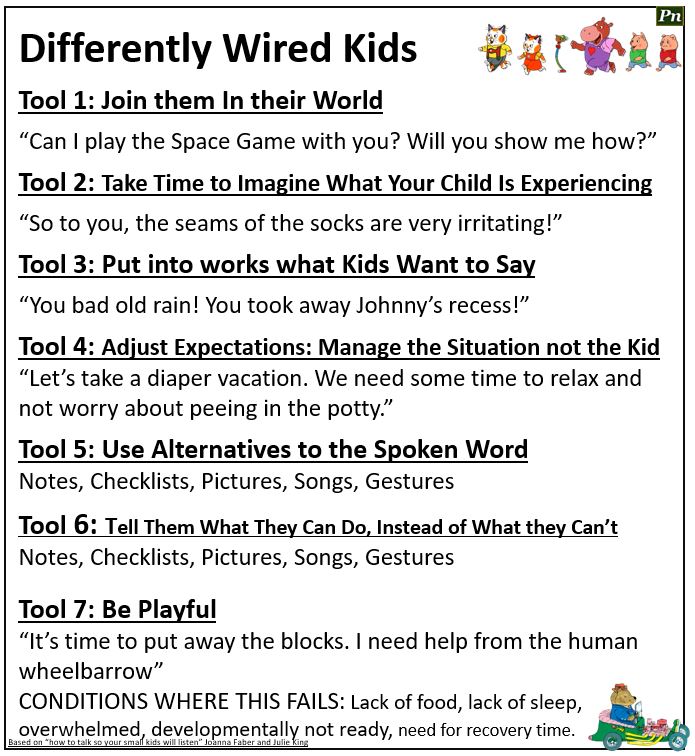
Differently Wired Kids
Tool 1: Join them In their World
- “Can I play the Space Game with you? Will you show me how?”
- You don’t want to have unrealistic expectations of your child.
- Optimistic plans get dashed. Have simple and less expensive disappointments. Setting expectations low is helpful with colleagues. If they surpass your expectations then you will be more grateful and they will feel more fulfilled. But don’t set expectations so low that it seem bigoted.
Tool 2: Take Time to Imagine What Your Child Is Experiencing
- “So to you, the seams of the socks are very irritating!”
- Handle frustration with your frustration and support. Be on your child’s side.
Tool 3: Put into works what Kids Want to Say
- “You bad old rain! You took away Johnny’s recess!”
Tool 4: Adjust Expectations: Manage the Situation not the Kid
- “Let’s take a diaper vacation. We need some time to relax and not worry about peeing in the potty.”
Tool 5: Use Alternatives to the Spoken Word
- Notes, Checklists, Pictures, Songs Gestures
- Difficult visual styles will help sink in what it is that you are trying to convey here.
Tool 6: Tell Them What They Can Do, Instead of What they Can’t
- Notes, Checklists, Pictures, Songs Gestures
- “You can throw your stuffed animals”
Tool 7: Be Playful
- “It’s time to put away the blocks. I need help from the human wheelbarrow”
- Don’t expect new skills to be used consistently.
Ensure the Following Conditions Have Been Met:
- Not hungry.
- Kids can’t act right when they don’t feel right.
- You don’t want to miss lunch! You have a fight and flight response, remember that the blood sugar level has to be in a reasonable range in order for any parenting techniques to work.
- Not sleepy.
- Not too rapid back to back.
- Not feeling overwhelmed.
- Not enough development or readiness for something new.
Part 2: Chapter 1
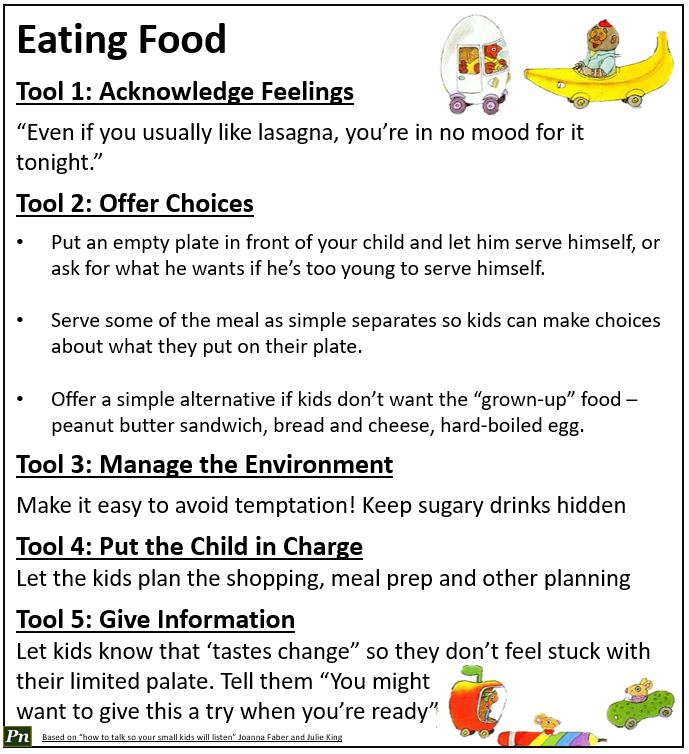
Eating Food
Meal Etiquette
- Don’t insist that your kids clean his or her plate, eat a specific food, or eat a predetermined amount; Maybe let the child pick what they want to eat. Put the food they would like on their plate.
- Don’t offer dessert as a reward for eating healthy food or withhold it as a punishment for not eating. It creates a negotiation where there shouldn’t be one. I’ll do this if you do that.
- Don’t be a short order cook. You should have a substitute perhaps, but don’t make it a constant.
- Don’t label your kid a “picky eater.”
- Don’t make food a battleground!
Tool 1: Acknowledge Feelings
- “Even if you usually like lasagna, you’re no in the mood for it tonight.”
Tool 2: Offer Choices
- Put an empty plate in front of your child and let him serve himself, or ask for what he wants if he’s too young to serve himself.”
- Serve some of the meal as simple separates so kids can make choices about what they put on their places.
- Offer a simple alternative if kids don’t want the “grown-up” food – peanut butter sandwich, bread and cheese, hard-boiled.
- Offer a simple alternative if kids won’t want the ‘adult food’.
Tool 3: Manage the Environment
- Make it easy to avoid temptation! Keep sweets and sugary drink
Tool 4: Put the Child in Charge
- Let the kids plan the shopping, meal prep and other planning
Tool 5: Give Information
- Let kids know that ‘tastes change” so they don’t feel stuck with their limited palate. Tell them “You might
- want to give this a try when you’re ready”
Part 2: Chapter 3
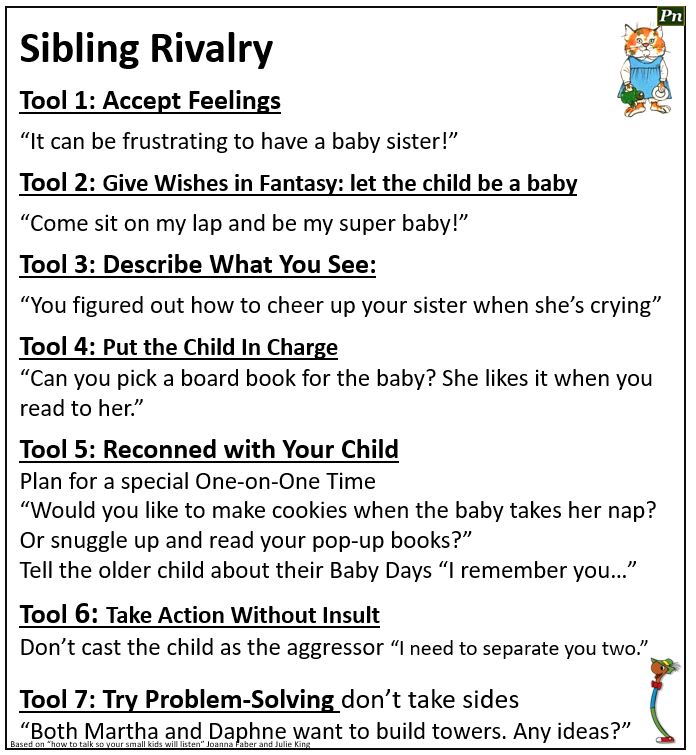
Sibling Rivalry
Tool 1: Accept Feelings
- “It can be frustrating to have a baby sister!”
Tool 2: Give Wishes in Fantasy: let the child be a baby
- “Come sit on my lap and be my super baby!”
- “Rock-A-Bye Baby” wrap the old child and sing that song.
Tool 3: Describe What You See:
- “You figured out how cheer up your sister when she’s crying”
- “Your old brother made peanut jelly sandwiches for us today!”
Tool 4: Put the Child In Charge
- “Can you pick a board book for the baby? She likes it when you read to her.”
- “Can you read to your sister?”
Tool 5: Reconnect with Your Child
- Plan for a special One-on-One Time
- “Would you like to make cookies when the baby takes her nap? Or snuggle up and read your pop-up books?”
- Tell the older child about their Baby Days “I remember you…”
Tool 6: Take Action Without Insult
- Don’t cast the child as the aggressor “I need to separate you two.”
Tool 7: Try Problem-Solving don’t take sides
- “Both Martha and Daphne want to build towers. Any ideas?”
- “This is a tough problem. We need ideas.”
Part 2: Chapter 5
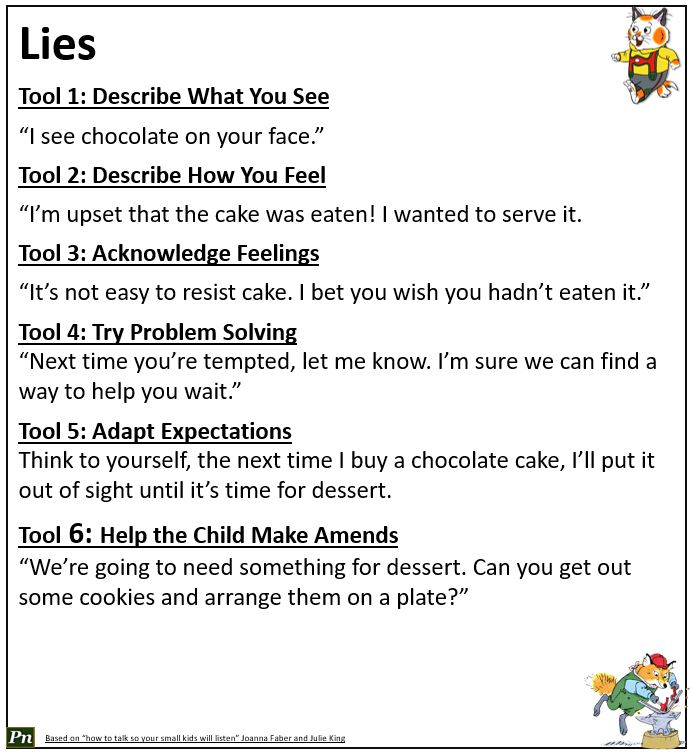
Lies
Tool 1: Describe What You See
- “I see chocolate on your face.”
Tool 2: Describe How You Feel
- “I’m upset that the cake was eaten! I wanted to serve it.”
Tool 3: Acknowledge Feelings
- “It’s not easy to resist cake. I bet you wish you hadn’t eaten it.”
Tool 4: Try Problem Solving
- “Next time you’re tempted, let me know. I’m sure we can find a way to help you wait.”
Tool 5: Adapt Expectations
- Think to yourself, the next time I buy a chocolate cake, I’ll put it out of sight until it’s time for dessert.
Tool 6: Help the Child Make Amends
- “We’re going to need something for dessert. Can you get out some cookies and arrange them on a plate?”
Part 2: Chapter 6
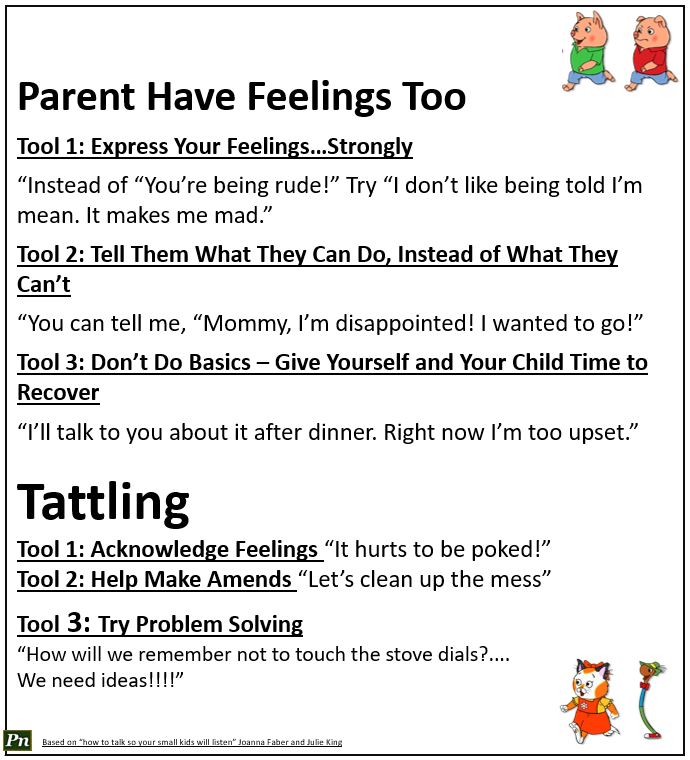
Parent Have Feelings Too
Tool 1: Express Your Feelings…Strongly
- “Instead of “You’re being rude!” Try “I don’t like being told I’m mean. It makes me mad.”
Tool 2: Tell Them What They Can Do, Instead of What They Can’t
- “You can tell me, “Mommy, I’m disappointed! I wanted to go!”
Tool 3: Don’t Do Basics – Give Yourself and Your Child Time to Recover
- “I’ll talk to you about it after dinner. Right now I’m too upset.”
Part 2: Chapter 7
Tattling
Tool 1: Acknowledge Feelings “It hurts to be poked!”
- Tattle for the pleasure of power. If you set up rules and one child tattles about something he did then it’s like building dirt on other people. “I can see why you would want to have me punish the other person here.”
Tool 2: Help Make Amends “Let’s clean up the mess”
Tool 3: Try Problem Solving
“How will we remember not to touch the stove dials? We need ideas”
Part 2: Chapter 8
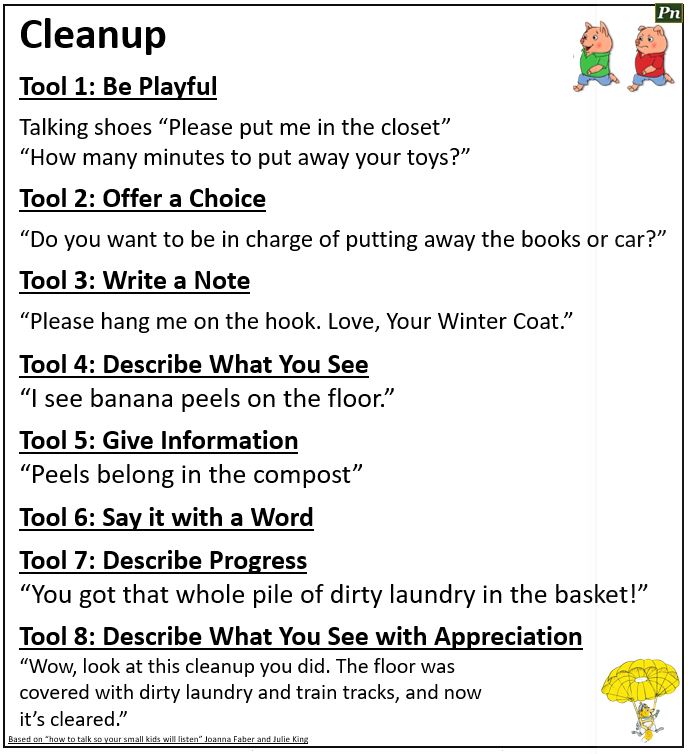
Cleanup
Tool 1: Be Playful
- Talking shoes “Please put me in the closet”
- “How many minutes to put away your toys?”
Tool 2: Offer a Choice
- “Do you want to be in charge of putting away the books or car?”
Tool 3: Write a Note
- “Please hang me on the hook. Love, Your Winter Coat.”
Tool 4: Describe What You See
- “I see banana peels on the floor.”
Tool 5: Give Information
- “Peels belong in the compost.”
Tool 6: Say it with a Word
Tool 7: Describe Progress
- “You got that whole pile of dirty laundry in the basket!”
Tool 8: Describe What You See with Appreciation
- “Wow, look at this cleanup you did. The floor was covered with dirty laundry and train tracks, and now it’s cleared.”
Part 2: Chapter 9
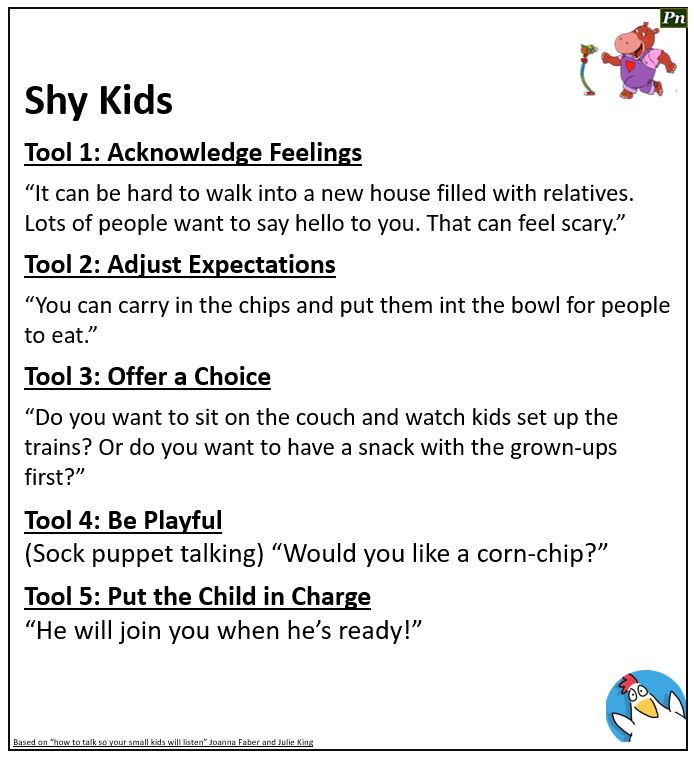
Shy Kids
Tool 1: Acknowledge Feelings
- “It can be hard to walk into a new house filled with relatives. Lots of people want to say hello to you. That can feel scary.”
Tool 2: Adjust Expectations
- “You can carry in the chips and put them into the bowl for people to eat.”
Tool 3: Offer a Choice
- “Do you want to sit on the couch and watch kids set up the trains? Or do you want to have a snack with the grown-ups first?”
Tool 4: Be Playful
- (Sock puppet talking) “Would you like a corn-chip?”
Tool 5: Put the Child in Charge
- “He will join you when he’s ready!”
Part 2: Chapter 10
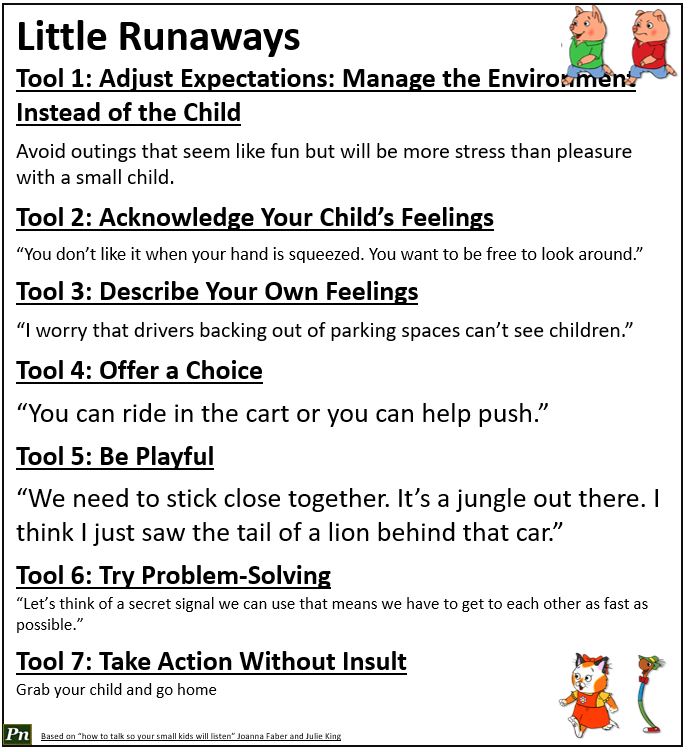
Little Runaways
Tool 1: Adjust Expectations: Manage the Environment Instead of the Child
- Avoid outings that seem like fun but will be more stress than pleasure with a small child.
Tool 2: Acknowledge Your Child’s Feelings
- “You don’t like it when your hand is squeezed. You want to be free to look around.”
Tool 3: Describe Your Own Feelings
- “I worry that drivers backing out of parking spaces can’t see children.”
Tool 4: Offer a Choice
- “You can ride in the cart or you can help push.”
Tool 5: Be Playful
- “We need to stick close together. It’s a jungle out there. I think I just saw the tail of a lion behind that car.”
Tool 6: Try Problem-Solving
- “Let’s think of a secret signal we can use that means we have to get to each other as fast as possible.”
Tool 7: Take Action Without Insult
- Grab your child and go home
Troubleshooting

Tool 1: When a child is too upset to cooperate, go back to Acknowledging Feelings
- “You don’t even want to think about visiting your friend another time. You were looking forward to going today!”
Make sure your tone of voice matches the emotion
- “That’s so disappointing!”
Try a grunt a instead of words
- “Ugh!” “Mmph!”
Put your child’s thoughts into words
- “Stupid Legos! They should stick together and stay together!”
Tell the Story of what happened
- “You worked for a long time on that spaceship. You used blue blocks for the base and red bricks for the lights and it was almost ready to launch! All it needed was the fins on the rockets.”
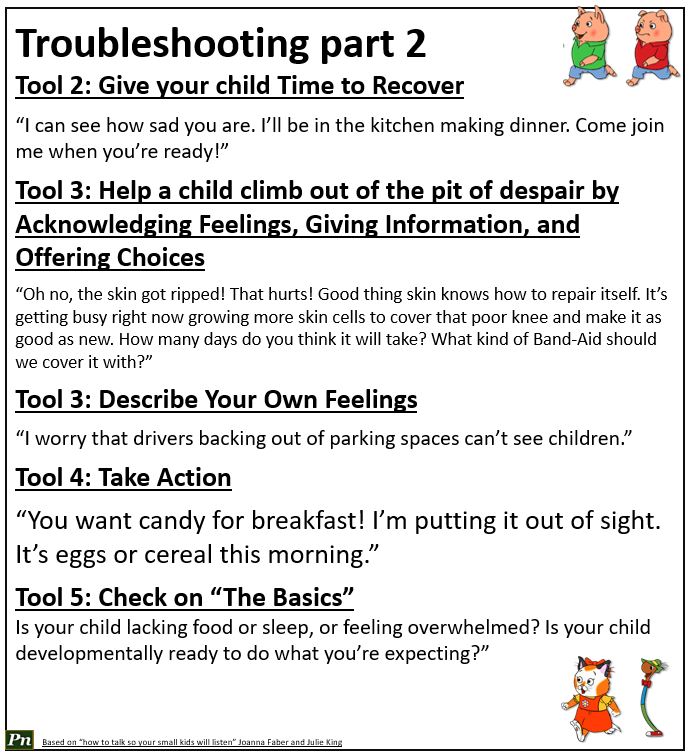
Tool 2: Give your child Time to Recover
- “I can see how sad you are. I’ll be in the kitchen making dinner. Come join me when you’re ready!”
Tool 3: Help a child climb out of the pit of despair by Acknowledging Feelings, Giving Information, and Offering Choices
- “Oh no, the skin got ripped! That hurts! Good thing skin knows how to repair itself. It’s getting busy right now growing more skin cells to cover that poor knee and make it as good as new. How many days do you think it will take? What kind of Band-Aid should we cover it with?”
Tool 3: Describe Your Own Feelings
- “I worry that drivers backing out of parking spaces can’t see children.”
Tool 4: Take Action
- “You want candy for breakfast! I’m putting it out of sight. It’s eggs or cereal this morning.”
Tool 5: Check on “The Basics”
- Is your child lacking food or sleep, or feeling overwhelmed? Is your child developmentally ready to do what you’re expecting?”
BUY THE BOOK BELOW:


